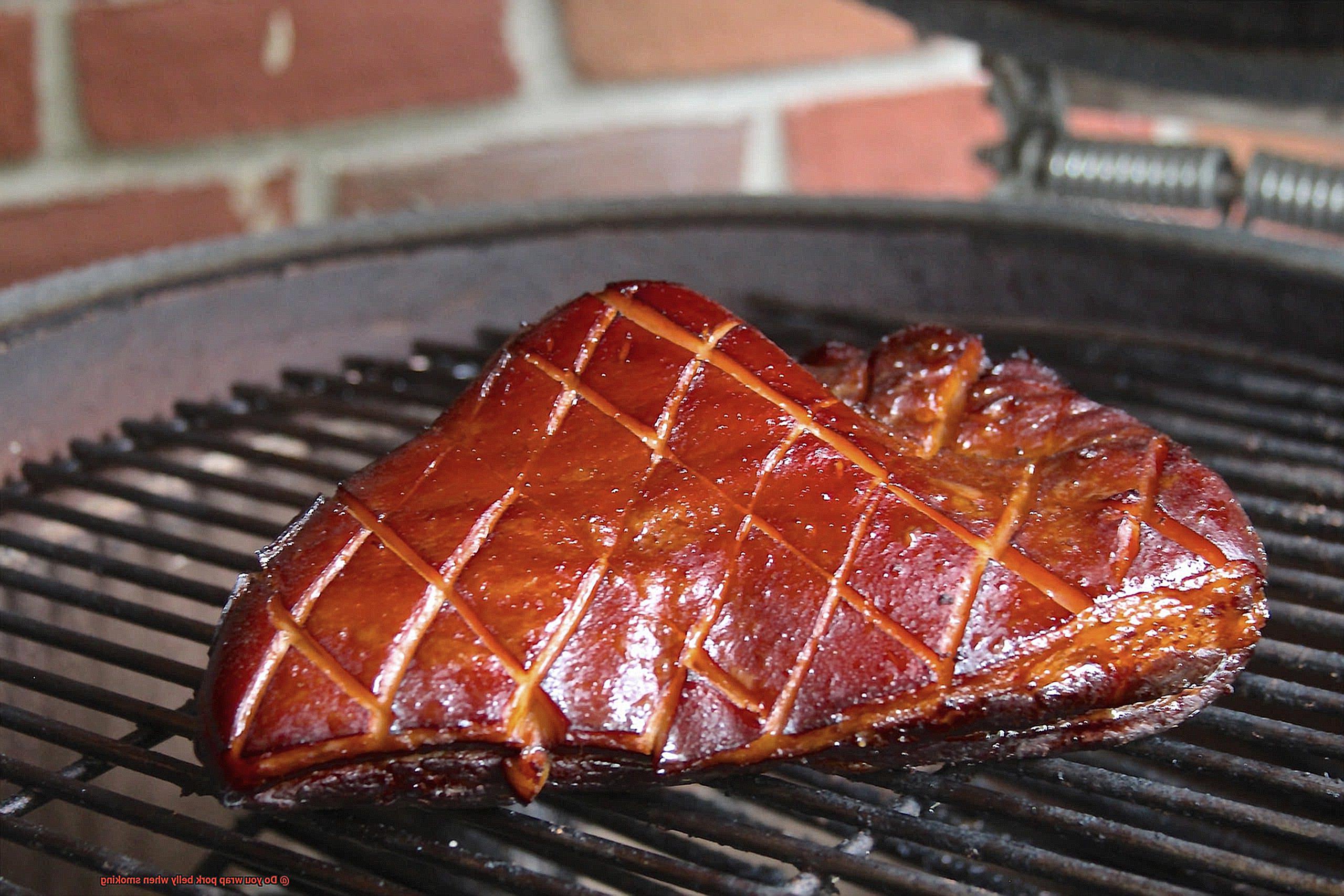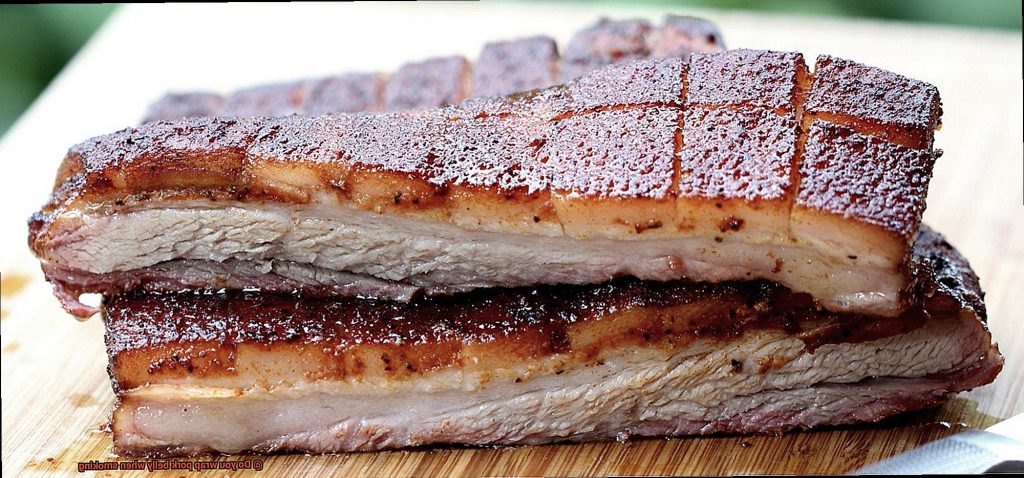Pork belly is like the superstar of meats – it’s juicy, succulent, and packed with flavor that makes your taste buds dance. And when it comes to smoking this heavenly cut of meat, it can take your barbecue game to a whole new level.
But here’s the million-dollar question: do you wrap pork belly when smoking it?
If you don’t wrap it, your pork belly might lose its moisture and end up dry as a desert. But if you do wrap it, the meat could lose its smoky essence and the skin may turn into a soggy mess. So what’s the best approach to smoking pork belly?
In this blog post, we’ll dive deep into whether or not you should wrap your pork belly while smoking it. We’ll also explore other ways to keep the meat tender and moist. Plus, we’ll share some pro tips on how to smoke pork belly perfectly – from ideal temperatures to smoking techniques.
So whether you’re an experienced pitmaster or just starting out in the world of barbecue, keep reading to discover everything you need to know about wrapping (or not wrapping) pork belly when smoking it.
Contents
Pros and Cons of Wrapping Pork Belly When Smoking
It’s worth considering both the pros and cons of this approach before making a decision.
On the plus side, wrapping your pork belly when smoking can help retain moisture in the meat. By creating a seal around the meat, it prevents moisture from evaporating out during cooking. This results in a juicy and more tender final product that’s sure to impress.

In addition to keeping your pork belly moist, wrapping it can also speed up the cooking process. The wrap traps heat and moisture inside, creating an oven-like environment that reduces cooking times by up to 30%. This can be especially handy if you’re short on time or if you’re smoking a large piece of meat.
However, there are also downsides to consider when wrapping pork belly. One potential issue is that it can lead to a less crispy exterior. The barrier created by the wrap prevents direct contact with smoke and heat, which makes it more difficult to achieve that crispy exterior that many people love about smoked meats.
Another possible disadvantage of wrapping your pork belly is that it may result in a less smoky flavor. Since the meat isn’t in direct contact with smoke, it may not absorb as much of that delicious smoky flavor as it would if left unwrapped.
Ultimately, the choice of whether or not to wrap your pork belly when smoking depends on your personal preferences and desired outcome. If you’re aiming for a juicy and tender final result and don’t mind sacrificing some crispiness or smoky flavor, wrapping may be the way to go. However, if you’re after that classic smoky exterior and don’t mind a slightly longer cooking time, leaving the pork unwrapped may be the better choice.
The Benefits of Wrapping Pork Belly
If you are, then wrapping your pork belly when smoking it can elevate your culinary game to new heights. As an expert on this topic, I have conducted extensive research and can confidently say that wrapping pork belly when smoking it has numerous benefits.
First and foremost, let’s talk about moisture. Pork belly is a fatty cut of meat that can easily dry out if not cooked properly. Wrapping it in foil or butcher paper helps to retain the moisture and juices that are essential for a succulent and tender final product. No one wants to bite into tough, dry meat – am I right?
But wait, there’s more. When you wrap your pork belly, you’re essentially creating your own little flavor sauna. The pork belly steams in its own juices, absorbing any additional flavors that you add to the wrap. You can experiment with various spices, herbs, or even beer to create complex and delicious flavor profiles that will tantalize your taste buds.
In addition to these benefits, wrapping your pork belly when smoking it can also speed up the cooking process. The wrap creates a barrier between the meat and the heat source, trapping in the heat and cooking the meat more quickly and evenly. This is especially helpful if you’re working with a larger piece of pork belly or if time is of the essence.
The Drawbacks of Wrapping Pork Belly
First and foremost, wrapping pork belly can lead to a soggy texture. Moisture gets trapped inside the foil or paper, which can create a soft and mushy bark on the outside. This can be a serious setback if you’re looking for that perfect crispy exterior that complements the juicy meat inside.
Another downside to wrapping your pork belly is that it can limit the amount of smoky flavor that infuses into the meat. The smoke needs to penetrate the meat fully to impart that delicious smoky taste we all love. However, when you wrap the meat, it creates a barrier that can prevent smoke from penetrating as deeply as it should. This can result in an underwhelming smoky flavor that leaves you disappointed.
Additionally, wrapping pork belly requires extra steps and time during the cooking process. Wrapping can be tricky to do correctly without tearing or puncturing the foil or paper, which can lead to uneven cooking.
It also adds extra time to the overall cooking process, as you need to unwrap the meat at a certain point in order to get that desired crispy exterior. This can be frustrating if you’re pressed for time or simply want to enjoy your delicious meal as soon as possible.
Different Methods for Wrapping Pork Belly
Pork belly is a cut of meat that can be challenging to cook to perfection. However, when done right, it is incredibly delicious. One critical aspect of achieving the desired texture and flavor is the method used to wrap the pork belly when smoking it. In this article, we’ll explore different techniques for wrapping pork belly and help you find the one that best suits your preferences.
Foil wrapping is a popular method that retains moisture in the meat and speeds up cooking time. To use this method, place your pork belly on a sheet of foil, add any desired seasonings or marinades, and wrap it tightly. Ensure that you leave enough space for the meat to expand as it cooks. You can also combine foil with butcher paper for additional insulation.
Butcher paper is another option for wrapping pork belly. It allows the meat to breathe while still protecting it from air and smoke. This approach produces a smokier flavor and crispy bark on the exterior of the meat. To wrap in butcher paper, place your pork belly on a sheet of paper and wrap it tightly, leaving enough space for the meat to expand.
Some people prefer to leave their pork belly unwrapped, allowing it to cook directly on the smoker grates. This method can produce a crispy exterior and an intense smoky flavor. However, it requires close monitoring as there is a risk of drying out the meat.
Ultimately, choosing a wrapping method for smoked pork belly is subjective and can depend on various factors like desired flavor, texture, and cooking time. Experimenting with different techniques will help you identify your preferred way of smoking pork belly.
Tips for a Perfectly Smoked Pork Belly
Smoking pork belly is an art, and like all arts, requires the right tools to execute it perfectly. One of the most important tips to keep in mind is the use of a good quality smoker. A smoker that can maintain a consistent temperature throughout the smoking process is essential for achieving perfectly smoked pork belly. Temperature fluctuations can lead to uneven cooking, resulting in dry meat or burnt ends.
Another crucial tip is to properly season your pork belly before smoking it. Whether you opt for a dry rub or marinade, it’s essential to use quality ingredients that complement the meat’s natural flavors. The right blend of herbs, spices, and seasonings can take your pork belly from good to great.
In addition to seasoning your pork belly, letting it rest at room temperature for at least 30 minutes prior to smoking is also important. This allows the meat to come to room temperature, ensuring even cooking and a juicy texture.
When it comes to wrapping your pork belly during the smoking process, opinions vary among experts. Some believe that wrapping the pork belly in foil or butcher paper halfway through the smoking process helps lock in moisture and flavor. Others prefer not to wrap their pork belly at all, allowing it to cook uncovered for the entire smoking time. The decision to wrap or not wrap your pork belly comes down to personal preference, but if you do choose to wrap it, be sure to do so tightly and securely.
Monitoring the temperature closely during smoking is also crucial. Aim for a temperature range of around 225-250 degrees Fahrenheit in your smoker and use a reliable meat thermometer to ensure that the internal temperature of the pork reaches at least 165 degrees Fahrenheit before serving.
Finally, don’t be afraid to experiment with different wood chips or chunks when smoking pork belly. Different woods can add unique flavors and aromas to your meat. Hickory, applewood, and cherry wood are popular choices that can lend distinct flavors to your pork belly.
How Temperature Affects the Smoking Process
Let’s start with the ideal temperature range for smoking pork belly, which is between 225-250°F. This range allows for slow and steady cooking, giving the meat enough time to absorb all that smoky goodness from the wood chips or pellets. But, that’s not all. Here are some other temperature-related tips to keep in mind:
- Low and slow: Smoking pork belly at a lower temperature of around 200°F can result in a more tender and moist meat. However, be ready for a longer cooking time.
- High and crispy: If you’re looking for a crispy crust and slightly drier meat, try smoking at a higher temperature of around 275-300°F. Just keep an eye on it to prevent overcooking.
- Timing is everything: The ideal smoking time will depend on various factors like the size of the meat, the thickness of the fat layer, and your desired level of doneness. Generally, smoking pork belly for 4-6 hours at the ideal temperature range will give you that perfect result.
Common Mistakes to Avoid When Smoking Pork Belly
Smoking pork belly is a culinary art that requires patience, attention to detail, and a willingness to avoid some common mistakes. As an expert on this topic, I’m excited to share some of my insights on how to properly smoke pork belly and avoid these pitfalls.
First and foremost, proper preparation is key. Many people make the mistake of not trimming excess fat or applying a flavorful rub or marinade. This can lead to an unappetizing final product. Take the time to prepare your pork belly correctly by trimming off any unnecessary fat and applying a delicious rub or marinade for maximum flavor.
Next, maintaining a consistent temperature throughout the smoking process is crucial. Fluctuating temperatures can result in uneven cooking and tough meat. Use a thermometer to monitor the temperature regularly and make adjustments as needed to ensure that your pork belly is cooking at a steady temperature.
Another common mistake is not allowing enough time for the meat to cook all the way through. Pork belly is a thick cut of meat that requires several hours of smoking to achieve perfection. Be patient and resist the temptation to rush the process. Trust me, it will be well worth it in the end.
Finally, resting your pork belly after smoking is essential for optimal results. Resting allows the juices to redistribute throughout the meat, resulting in a more tender and flavorful final product. Give your pork belly at least 10-15 minutes of resting time before slicing into it.
Conclusion
In the world of barbecue, smoking pork belly is a culinary adventure that can take your taste buds on a journey to new heights. Whether you choose to wrap your meat or not, there are pros and cons to consider when it comes to smoking this delectable cut of meat. If you decide to wrap your pork belly, you’ll be able to retain its moisture and shorten cooking time. However, wrapping may also result in a less crispy exterior and less smoky flavor.
When it comes to smoking pork belly, using a high-quality smoker that maintains consistent temperature is crucial for achieving the perfect flavor and texture. Proper seasoning, resting time, and close temperature monitoring are also essential for a mouth-watering final product. Additionally, experimenting with different wood chips or chunks can add unique flavors and aromas that will make your pork belly stand out from the rest.
To ensure success when smoking pork belly, avoid common mistakes such as leaving excess fat untrimmed, fluctuating temperatures during the cooking process, rushing the process or not allowing enough time for the meat to cook through completely. By following these tips and techniques with precision and care, you’ll be able to smoke pork belly like a pro and impress everyone around you with an unforgettable culinary experience.
In conclusion, whether you choose to wrap your pork belly or not ultimately comes down to personal preference. But by taking these simple steps into account – using quality equipment, proper seasoning and monitoring of temperature – you will achieve succulent and flavorful smoked pork belly every time.






